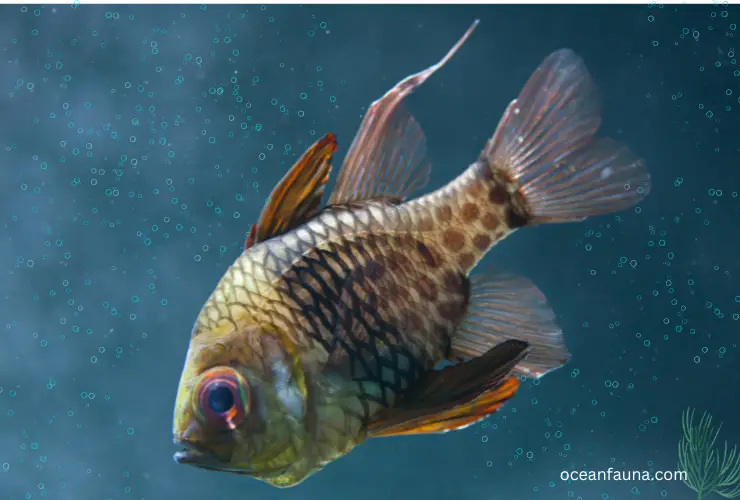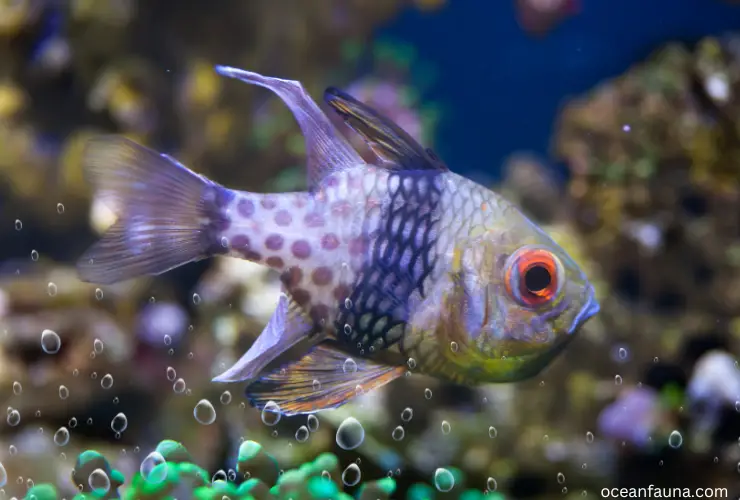Pajama Cardinalfish is one of the most popular marine aquarium fish among aquarists for its appearance. These fish have a distinct appearance, with a vibrant orange-red body and two horizontal white stripes on each side of their body.
It is named for its two paired rows of alternating black and white stripes that run along its body, resembling the striped pattern often found on pajamas.
If you already know about this beautiful underwater creature, my article will give you an in-depth look at every aspect of its life.
About: Pajama Cardinalfish
| Category | Information |
| Common Names | Pajama Cardinalfish |
| Scientific Name | Sphaeramia nematoptera |
| Order | Perciformes |
| Family | Apogonidae |
| Diet | Carnivorous, feeds on small crustaceans and plankton |
| Habitat | Coral reefs, lagoons, and protected bays |
| Distribution | Western Pacific region |
| Size | Up to 3.3 inches (8.5 cm) |
| Life Expectancy | Up to 5 years |
| Reproduction | Egg layers, males guard and aerate eggs |
| Conservation Status | Least Concern |
Native to the Western Pacific Ocean, from Java and Fiji all the way to the Ryukyu Islands and Great Barrier Reef, one can find an abundance of Pajama Cardinalfish (Sphaeramia nematoptera). This species belongs to the Apogonidae family and stands out for its unique features.
They have a small, triangular head and large, expressive eyes. Pajama Cardinalfish exhibit sexual dimorphism, with the females having a more rounded body shape and males having a more elongated body.
In the wild, Pajama Cardinalfish live in groups, and they are usually found in coral reefs, especially in areas with plenty of hiding spots. They are very peaceful and non-aggressive towards other fish, making them an excellent addition to community aquariums.
Pajama Cardinalfish are carnivores, which means they eat meat. They primarily feed on zooplankton and small invertebrates in the wild, but they will readily accept a variety of foods in captivity, including frozen and live foods, as well as commercial fish food.
Breeding Pajama Cardinalfish in captivity can be somewhat challenging, as they require specific conditions to spawn successfully. Once they do spawn, however, they are known to be excellent parents, with both males and females sharing the responsibility of caring for their eggs and young.
Interesting Facts: Pajama Cardinalfish
- The name “Pajama Cardinalfish” comes from the striped pattern on its body, which is similar to pajamas.
- Pajama Cardinalfish are monogamous and will form long-term pair bonds with a single mate for life.
- Male Pajama Cardinalfish exhibit parental care, which is very rare in fish species. They will guard the eggs and fry until they can fend for themselves.
- Pajama Cardinalfish are nocturnal and prefer to rest during the day, hiding in crevices in the rocks or coral.
- These highly sociable fish should be kept in groups of at least 3 individuals.
- Due to their small size, Pajama Cardinalfish can be an ideal choice for nano tanks and reef aquariums.
- These fish are relatively easy to care for but sensitive to drastic changes in water parameters and quality. Regular maintenance is essential for keeping them healthy.
- Pajama Cardinalfish have been bred in captivity for the aquarium trade, but wild-caught specimens are more commonly available.
Anatomy of Pajama Cardinalfish
Pajama Cardinalfish are beautiful and have unique anatomical structures that make them stand out. Let’s take a closer look at some of the different anatomical systems in the pajama cardinalfish.
Skeletal System
The pajama cardinalfish’s skeletal system comprises bones that provide structure and support to the fish’s body. The bones of the fish are made up of a protein called collagen, which gives them flexibility and strength. The skull of the fish is also made up of several bones that are tightly fused together, giving the fish protection and support for its brain.
Muscular System
The muscular system of the pajama cardinalfish is responsible for the movement of the fish’s body. The fish has two main muscle groups, the axial and appendicular muscles. The axial muscles run along the length of the fish’s body and are responsible for the fish’s swimming movements, while the appendicular muscles are responsible for the fish’s pectoral and pelvic fin movements.
Digestive System
The digestive system of the pajama cardinalfish consists of the mouth, esophagus, stomach, intestines, liver, and pancreas. These organs work together to break down food and absorb nutrients from it. The fish’s mouth is designed to capture small prey like zooplankton and small crustaceans, and its stomach is able to stretch to accommodate the food it eats.
Circulatory System
The circulatory system of the pajama cardinalfish is responsible for transporting oxygen and nutrients throughout the fish’s body. The fish has a two-chambered heart that pumps blood to its gills and is oxygenated before being circulated to the rest of the body. The fish also has a closed circulatory system, meaning that its blood is always contained within vessels.
Respiratory System
The respiratory system of the pajama cardinalfish is responsible for taking in oxygen and getting rid of carbon dioxide. The fish has gills that are designed to extract oxygen from the water. Oxygen is extracted as water flows over the gills, and carbon dioxide is released.

How Big Is A Pajama Cardinalfish?
The maximum length of a Pajama Cardinalfish is 3.3 inches (8.5 cm). This species of fish is relatively small and is considered a dwarf cardinalfish. They are usually found in the Western Pacific Ocean, particularly in the Indo-Pacific region.
Although small, Pajama Cardinalfish are popular among aquarium enthusiasts due to their peaceful disposition, ease of care, and unique appearance. They are a social species and should be kept in groups of at least 3-4.
What Do Pajama Cardinalfish Eat?
Like many other fish species, Pajama Cardinalfish requires a well-balanced diet to maintain their overall health and longevity. Their primary source of food in the wild is small crustaceans, which they hunt at night.

They prefer a meaty diet rich in protein when kept in an aquarium. Frozen foods like mysis shrimp and brine shrimp are their preferred food types. These foods are easily available and can be purchased at most local pet stores.
However, they are primarily carnivores and, thus, require a diet that includes a varied mix of fresh and frozen foods to ensure they get all the necessary nutrients.
Providing Pajama Cardinalfish with a mixed diet that includes pellets and flake food is essential. This variety ensures they receive all the necessary minerals and vitamins to stay healthy. Pellets and flake food should be the base of their diet and supplemented with frozen or live foods as needed.
Pajama Cardinalfish are small fish whose stomachs are tiny, so it is necessary to feed them small amounts of food several times a day. Feeding them smaller quantities of food multiple times a day is better than giving them one large meal a day. Overfeeding them can lead to health issues like bloating, constipation, and other digestive problems.
Where Do Pajama Cardinalfish Live?
The Pajama Cardinalfish is found in the Western Pacific Ocean, spanning a wide range from Java and Fiji to the Ryukyu Islands and Great Barrier Reef. These fish prefer to dwell in calm waters near the reefs and are typically found at depths of around 1 to 14 meters.
They favor reefs that are covered with branched corals, such as Acropora species, and occasionally utilize Porites nigrescens and Porites cylindrica. During the day, they seek shelter in these corals and are incredibly adaptive to their natural environment.
When placed in captivity, Pajama Cardinalfish exhibit general tank conditions that are easy to maintain. The ideal water temperature range for these fish is 74 to 78 degrees, and salinity should be maintained at a level of 1.020 to 1.025. However, with this low level of maintenance required, these vibrant and colorful fish are a beautiful addition to any saltwater tank.
They are friendly and gentle and are a favorite of many aquarium hobbyists. Therefore, owing to their adaptability and ease of care, Pajama Cardinalfish is a popular choice for people looking to incorporate marine life into their homes.
What Is the Lifespan of Pajama Cardinalfish?
The lifespan of Pajama Cardinalfish is relatively short, typically ranging from 2 to 5 years in the wild. In captivity, however, they can live up to 8 years or more with proper care.
As with most fish, the lifespan of Pajama Cardinalfish can vary depending on several factors, including genetics, diet, water quality, and environmental conditions. In the wild, they are subject to predation and can also be affected by changes in water temperature and salinity.
In captivity, Pajama Cardinalfish are generally hardy and easy to care for. They can thrive in a variety of tank sizes, but a minimum of 20 gallons is recommended to give them sufficient space to swim and hide. To feel secure, they prefer a peaceful environment with plenty of hiding spots, such as live rock or coral.
A varied diet is essential to maintaining the overall health and well-being of Pajama Cardinalfish. Regular water changes and proper filtration are also crucial for keeping Pajama Cardinalfish healthy and extending their lifespan in captivity. High levels of nitrate and ammonia can be harmful to their health, so monitoring these levels and doing routine maintenance is critical.
How Do Pajama Cardinalfish Reproduce?
Pajama cardinalfish are egg-laying and reproduce by spawning. During the breeding season, which typically occurs in the summer months, the males become very aggressive and territorial. They will chase away any potential predators or competitors to protect their mate and the eggs.
Once the male chooses a suitable location for spawning, the female will lay her eggs, and the male will immediately fertilize them. The female then leaves the area, and the male takes over the task of protecting the eggs until they hatch.
The male will hold the eggs in his mouth for approximately 3-4 weeks until the eggs completely develop and the fry is ready to hatch. During this time, the male will not eat and will face many challenges, including evading predators and maintaining the ideal water temperature and quality for the eggs.
After the eggs hatch, the fry will remain in the male’s mouth for several more days until they are large enough to venture out on their own. The male will continue to protect the fry during this time and may also provide food for them by regurgitating small bits of food.
What Is the Conservation Status of Pajama Cardinalfish?
The IUCN Red List of Threatened Species has recently assessed the conservation status of the Pajama Cardinalfish, scientifically known as Sphaeramia nematoptera, and has listed it as Least Concern. This indicates that the population of this species is not significantly threatened, and its survival is relatively stable in its natural habitat.
The Pajama Cardinalfish was assessed based on several factors, including its population size, distribution, trend, and the threats it faces in the wild. The species has a wide distribution range that spans from the Philippines, Indonesia, and Malaysia to the Solomon Islands and is commonly found in a variety of reef habitats, including shallow lagoons and seaward reefs.
While the Pajama Cardinalfish may face some localized threats, such as overfishing and habitat destruction in some areas of its range, these impacts are considered to be minor and are not significant enough to pose a major threat to the overall population of the species.
Therefore, the IUCN Red List assessment has classified the Pajama Cardinalfish as of Least Concern.
Conclusion
Hopefully, you have a detailed knowledge of Pajama Cardinalfish. Here I have discussed the anatomy, diet, habitat, behaviors, conservation status, and interesting facts about this species.
If you have any questions about this fish, let me know. I will answer them as soon as possible.

